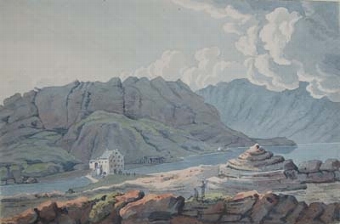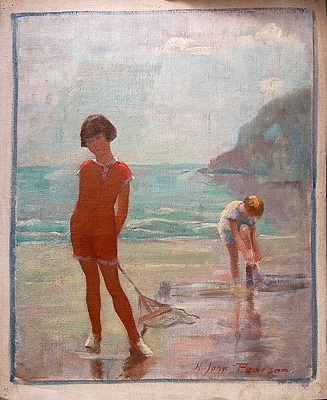crowd scene at cheltenham gold cup day, 1960
- View other items in:
- antiques interior design modern and vintage
- other interior design
artware ltd
Enquire about this antique
Artware Ltd has 565 antiques for sale.
click here to see them all
The Cheltenham Gold Cup is a Grade 1 National Hunt chase in the United Kingdom which is open to horses aged five years or older. It is run on the New Course atCheltenham over a distance of about 3 miles and 2? furlongs (5,331 metres), and during its running there are twenty-two fences to be jumped. The race is scheduled to take place each year during the Cheltenham Festival in March. It is the most prestigious of all National Hunt events, and it is sometimes referred to as the Blue Riband of jump racing. Its roll of honour features the names of such highly acclaimed chasers as Arkle, Golden Miller, Kauto Star and Mill House. The Gold Cup is at present the most valuable non-handicap chase in Britain, and in 2010 it offered a total prize fund of ?475,000. The chase has previously been sponsored by Totesport but from 2012 will be sponsored by Betfred, after Betfred bought the government-owned Tote in June 2011 in a deal worth ?265m. The first horse race known as the Cheltenham Gold Cup took place in July 1819. It was a flat race, and it was contested over 3 miles on Cleeve Hill, which overlooks the present venue. The inaugural winner, Spectre, won a prize of 100 guineas for his owner. The Cheltenham Gold Cup was first run as a jumps race on March 12, 1924. A prize of ?685 was awarded to the owner of the winning horse. The event originally took place on what is now the "Old Course" at Cheltenham. In its early years it was overshadowed at the Festival by another race, the National Hunt Chase. The Gold Cup was abandoned in 1931 (because of frost) and 1937 (flooding), but the five intervening years saw the emergence of the most successful horse in the event''s history. All five races from 1932 to 1936 were won by Golden Miller, who also won the Grand National in 1934. During World War II the Gold Cup was cancelled twice, in 1943 and 1944. The first multiple winner of the post-war years was Cottage Rake, who won the three runnings from 1948 to 1950. Cottage Rake was trained in Ireland by Vincent O''Brien, and his successes helped to popularize the Gold Cup, and the Festival itself, with the Irish public. The Gold Cup was switched to the "New Course" in 1959, and this is now the regular track used for the event. In the mid 1960s the race was dominated by Arkle, who won three consecutive runnings from 1964 to 1966. Such was Arkle''s perceived superiority before the last of these victories that he was given a starting price of 1/10 (a ?10 bet would have won ?1). He remains the shortest-priced winner in the race''s history. The first commercial sponsorship of the race was by Piper Champagne, which began supporting the event in 1975. The Tote (now known as Totesport) became the sponsor in 1980. The most remarkable feat in the Gold Cup by a trainer came in 1983, when Michael Dickinson was responsible for all of the first five horses to finish ? Bregawn, Captain John, Wayward Lad, Silver Buck and Ashley House. The 1986 winner, Dawn Run, is the only horse to have ever won both this race and the leading hurdle event, the Champion Hurdle. One of the most popular horses to win the Gold Cup was Desert Orchid, agrey who won the event in 1989. The following year''s running was won by Norton''s Coin, whose starting price of 100/1 represents the race''s longest ever winning price. The entire Cheltenham Festival was cancelled in 2001 because of an outbreak of foot-and-mouth disease. A replacement for the Cheltenham Gold Cup ? the Gold Trophy Chase ? was contested at Sandown in late April, but the Racing Post stated that this "lacked any strength in depth and was no substitute for the Gold Cup".[3] The next three runnings were all won by Best Mate, who is the most recent of the four horses to have won the race three or more times. In 2009, Kauto Star became the first horse to regain the Gold Cup. He overcame his stablemate and conqueror in 2008, Denman, who had recovered from a heart condition to take his place in the race.[4] Timeformspokesperson Kieran Packman said of Kauto Star''s performance, "it is the best Gold Cup-winning figure since the Arkle era in the mid-1960s".Kauto Star failed to regain the cup in 2010, falling four from home despite being odds-on favourite. One of the cups, a different one being awarded each year, was reported stolen on 14 July 2010 after a burglary at a home in Wormington, Gloucestershire.
Antiques.co.uk Ref: F4G7CDFK
- Materials:
- Pencil Drawing
- Width (cm):
- 40 x 90 in. (102 x 229 cm.)
Artware Ltd
Artware Fine Art specialises in fine antique, decorative and historical portraits and topographical pictures . We cover a period from the 17th and 18th centuries through to the 19th & 20th Centuries. We have over 150 portraits in stock, which can be viewed on our web site, each historical portrait has well researched biographical information both on the sitter and the artist.
Contact details
18 La gare
51 Surrey row
London
Greater London
SE1 0BZ
UNITED KINGDOM
T: 0207 921 97904
E: greg@artwarefineart.com
W: www.artwarefineart.com














